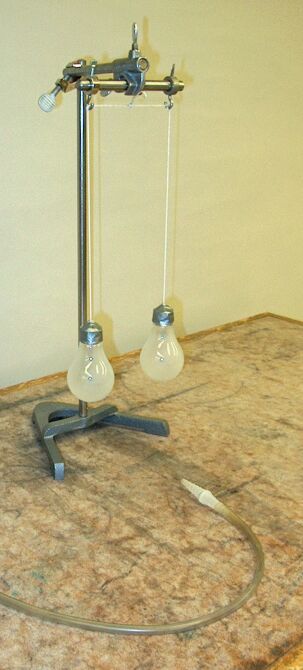

With the air hose (with the plastic connector on the end), blow a fast-moving air stream between the suspended bulbs. They will clatter against each other as long as the air stream flows between them. The air flow must be fast, but it need not be excessively so. Since the bulbs are suspended by string, it helps if the dynamic pressure provided by the air (vide infra) has a significant component along the string, so that the bulbs do not fly around. It is best to aim the air downwards from behind the bulbs. This way, the strings will remain taught, and the bulbs will stay together. (It helps to have the loop in the center placed over the thumbscrew at the top, to prevent either bulb from being forced downwards and pulling the other one up. This is not shown in the photograph above.)
What is happening?
The physics of this situation is described by Bernoulli’s theorem, which describes the steady flow of a nonviscous, incompressible fluid. It states that
p + (1/2)ρv2 + ρgy = constant.
(Some people might be used to seeing this equation stated as (p/ρ) + (1/2)v2 + φ = constant, where φ = gy.) This is strictly true only for flow along a particular streamline of the fluid. If, however, we make the additional simplification that the flow is irrotational, then it applies for flow at any point in the fluid. This equation contains the sum of the static pressure, the pressure that would be present even if there were no flow, which is p + ρgy, and the dynamic pressure, (1/2)ρv2, which arises from the fluid flow. A note on its derivation follows the explanation of the demonstration.
When you aim the air stream between the bulbs, since the air between the bulbs is flowing, the static pressure in that region is reduced, as the Bernoulli equation tells us. Everywhere else, the air around the bulbs is stagnant, so it exerts atmospheric pressure on them. This is greater than the reduced pressure between the bulbs, and the bulbs are forced towards each other. As the bulbs get closer together, the air flowing between them must flow faster and faster, thus further reducing the pressure between the bulbs. Once the bulbs touch, the air cannot pass, so the static pressure can increase, but as soon as the bulbs separate only slightly, a fast-moving stream of air is re-established between them, causing them to be pushed together again. The bulbs thus clatter as you blow the air stream between them.
This is similar to what happens when you take two pieces of paper facing each other and, by blowing between them, try to blow them apart. This would also make a good demonstration or student exercise.
One can arrive at the Bernoulli equation in one of at least two ways. It arises from a formal mathematical treatment of the equations of motion for a fluid, which are similar to those for electrodynamics. Since it is essentially a statement of the conservation of energy, one can also derive it by means of the work-energy theorem. We can envision fluid flowing through a tube with an entrance having a particular cross-sectional area, A1, and an exit at a different height, with an area A2. If we consider a particular volume of fluid at the entrance and at the exit, these correspond to a length l1 at the entrance and l2 at the exit. If we call the entrance pressure p1, the exit pressure p2, and the entrance and exit heights y1 and y2, respectively, we can calculate the total work done on the fluid (by the sum of pressure and gravitational forces) as p1A1l1 - p2A2l2 - mg(y2 - y1). The product of area and length is volume, which we can also write as m/ρ, so this becomes (p1 - p2)(m/ρ) - mg(y2 - y1). By the work-energy theorem, this work must equal the kinetic energy change for the volume element, which we can express as (1/2)mv22 - (1/2)mv12. Equating these gives:
(p1 - p2)(m/ρ) - mg(y2 - y1) = (1/2)mv22 - (1/2)mv12,
which we can rearrange as p1 + (1/2)ρv12 + ρgy1 = p2 + (1/2)ρv22 + ρgy2. Since the subscripts can refer to any two points along the tube, we can drop them and replace the right side of this equation with a constant to give the Bernoulli equation as stated above.
References:
1) Feynman, Richard P., Leighton, Robert B. and Sands, Matthew. The Feynman Lectures on Physics, Volume II, Mainly Electromagnetism and Matter (Reading, Massachusetts: Addison-Wesley Publishing Company, 1963) 40-2 to 40-9.
2) Resnick, Robert and Halliday, David. Physics, Part One, Third Edition (New York: John Wiley and Sons, 1977), pp. 386-391.